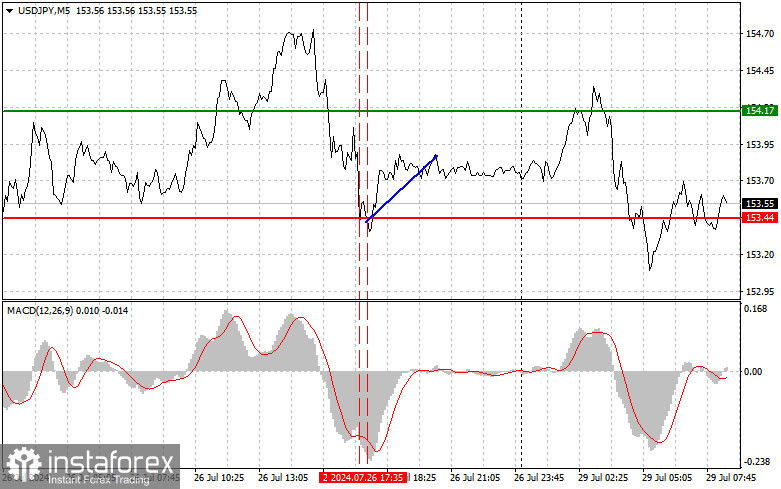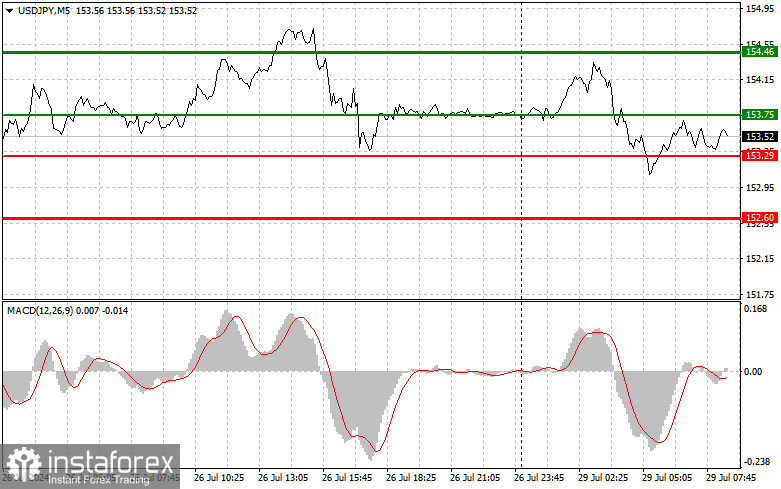Overview of trading and tips on USD/JPY
The price test of 153.44 occurred when the MACD indicator had already moved significantly below the zero mark, which limited the pair's downward potential. For this reason, I did not sell and decided to wait for suitable entry points to implement scenario No. 2 for buying. Shortly afterward, another price test of 153.44 happened when the MACD was already in the oversold area so traders could enter the market. As a result, USD/JPY rose by more than 40 pips. Today will be relatively calm, but as you can see, the pressure on the dollar has not disappeared, and the more discussions there are about rate cuts in the U.S. this week and raising rates in Japan, the lower we will see the USD/JPY pair. It is best to follow the bearish trend and look for entry points into the market as high as possible. As for the intraday strategy, I will rely more on implementing scenarios No. 1 and 2.

Buy signals
Scenario No. 1. Today, I plan to buy USD/JPY when the price reaches the entry point around 153.75, plotted by the green line on the chart, with the goal of rising to the level of 154.46 plotted by the thicker green line on the chart. Around 154.46, I will exit long positions and open short ones in the opposite direction, expecting a movement of 30-35 pips in the opposite direction from that level. The pair can only rise today within the framework of an upward correction. Before buying, ensure the MACD indicator is above the zero mark and just starting to rise from it.
Scenario No. 2. I also plan to buy USD/JPY today in case of two consecutive tests of 153.29 when the MACD indicator is in the oversold area. This will limit the pair's downward potential and lead to a reverse market upturn. One can expect growth to the opposite levels of 153.75 and 154.46.
Sell signals
Scenario No. 1. I plan to sell USD/JPY today only after testing the level of 153.29 plotted by the red line on the chart, which will lead to a rapid decline in the pair. The key target for sellers will be 152.60, where I will exit short positions and immediately open long positions in the opposite direction, expecting a movement of 20-25 pips in the opposite direction from that level. Pressure on USD/JPY may return at any moment, especially if the price fails to consolidate around the intraday high. Before selling, ensure the MACD indicator is below the zero mark and starting to decline.
Scenario No. 2. I also plan to sell USD/JPY today in case of two consecutive price tests at 153.75 when the MACD indicator is in the overbought area. This will limit the pair's upward potential and lead to a reverse market downturn. One can expect a decline to the opposite levels, 153.29 and 152.60.

What's on the chart:
The thin green line is the entry price at which you can buy the trading instrument.
The thick green line is the estimated price where you can set Take-Profit (TP) or manually close positions, as further growth above this level is unlikely.
The thin red line is the entry price at which you can sell the trading instrument.
The thick red line is the price where you can set Take-Profit (TP) or manually close positions, as further decline below this level is unlikely.
MACD line: it is important to be guided by overbought and oversold areas when entering the market
Important: Novice traders in the forex market need to be very careful when making decisions to enter the market. It is best to stay out of the market before important fundamental reports are released to avoid getting caught in sharp price fluctuations. If you decide to trade during news releases, always place stop orders to minimize losses. Without setting stop orders, you can quickly lose your entire deposit, especially if you don't use money management and trade in large volumes.
And remember, for successful trading, it is necessary to have a clear trading plan, similar to the one I presented above. Spontaneously making trading decisions based on the current market situation is inherently a losing strategy for an intraday trader.
 English
English 
 Русский
Русский Bahasa Indonesia
Bahasa Indonesia Bahasa Malay
Bahasa Malay ไทย
ไทย Español
Español Deutsch
Deutsch Български
Български Français
Français Tiếng Việt
Tiếng Việt 中文
中文 বাংলা
বাংলা हिन्दी
हिन्दी Čeština
Čeština Українська
Українська Română
Română

